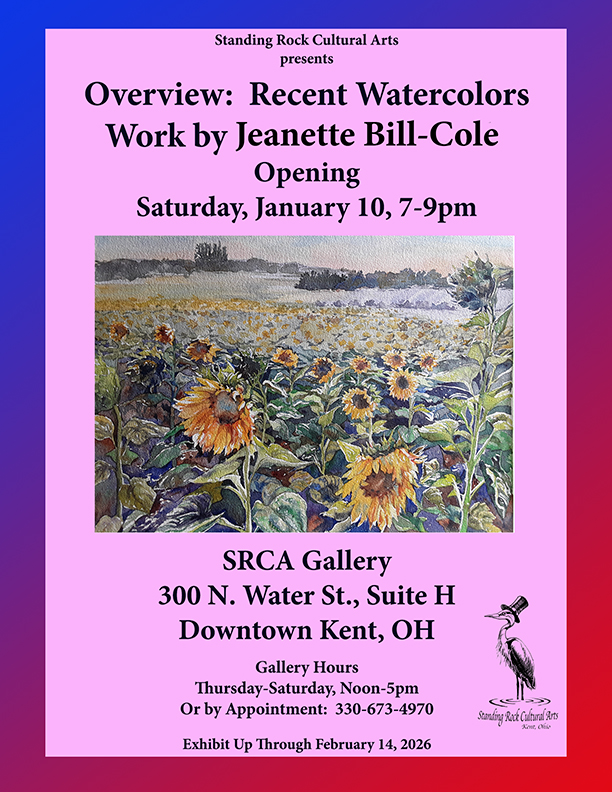Exhibitions
Who Was Edwin George? Cherokee Artist
June 1, 2024 7:00 PM
Greetings,
FOR IMMEDIATE RELEASE
Contact:
Standing Rock Cultural Arts
300 N. Water St., Suite H.
Kent, OH 44240
Phone: 330-673-4970
http://www.standingrock.net
info@standingrock.net
WHO: Standing Rock Cultural Arts presents
WHAT: WHO WAS EDWIN GEORGE – CHEROKEE?
-Edwin was a member of The Eastern Band Cherokee. The Eastern Band Cherokee are descendants of the Cherokee who resisted the Trail of Tears, and remained in North Carolina when the rest of the tribe was forcibly moved to Oklahoma in 1836. The majority of the Cherokee tribe are in Oklahoma.
-Edwin lived from 1934to June 30, 2022. He spent many of his adult years in Kent Ohio. He was married to Ellene George from Brimfield, who he met while she was working at a Holiday Inn in Cherokee North Carolina.
-Edwin designed the “Love” Mural that is painted on the North Wall of Scribbles Coffee Shop, 237 N. Water St., Kent, Ohio 44240.
WHERE: SRCA Gallery. 300 N. Water St., Suite H., Kent, OH
WHEN: Opening Reception on Saturday, June 1. 7pm-9pm
-Exhibit Up Through June 29
CONTACT: 330-673-4970
GALLERY HOURS : Wednesday-Saturday, noon-5pm
-or by appointment at 330-673-4970.
WHO WAS EDWIN GEORGE?
Edwin George, a member of the Eastern Band of Cherokees, was born in 1934 and raised in a mountain-side log cabin in Cherokee, NC. He grew up with limited educational opportunities, but in a home rich with native culture,stories, myths, and traditions. As a youth he and his family spoke only the Cherokee language.
Though Edwin’s parents had minimal education and worked labor-type jobs, both taught him to honor the stories and legends of the Cherokee people. His mother’s sister, Martha Owl, was a master basket weaver, and Edwin remembers watching her dedication to her craft. Edwin left the reservation to find better employment opportunities, and eventually learned to speak some English.
His marriage and life experience brought him to Ohio, where he worked for over 20 years as a custodian at Ohio State and Kent State Universities. During this time, he began to work with wood, whittling, carving, and painting totem poles, hiking sticks, and small sculptures. He once built a totem pole so large and detailed that he wasn’t able to get it out of his small home after assembling it. His passion to make art intensified.
In 1991, Edwin began to paint. His very first painting was the cabin of his youth, perched upon a tree covered mountainside. He labored over it,hesitantly trying to paint a realistic looking cabin. After that first attempt, a flood of Cherokee images, stories, myths, colors,animals and foliage flowed into his mind, and he realized that after all of this time, he needed to share his knowledge of the Cherokee language, culture, and mythology.
He had always been tentative about sharing his culture because of his limited English-speaking abilities, but found that, through his paintings, he could share and express an abundance of his history without being hindered by his limited language skills.
He painted totem poles, carved wood sculptures, and fashioned hiking sticks. He finally began painting in 1991 at the age of 57. Through his painting, George shared his personal history and cultural traditions.He typically painted Cherokee stories and myths, often including Cherokee words in his artwork along with guides for English translation and phonetic pronunciation. His art used vibrant colors and designs that create a sense of movement as if his paintings told a story. George hoped to keep this language alive through his artwork, sharing his traditional stories with the world while passing along this cultural heritage to future generations.
EASTERN BAND CHEROKEE HISTORY
The Eastern Band members are descended primarily from about 800 Cherokees living along the remote Oconaluftee River who were not forcibly subjected to theT rail of Tears to Indian Territory (now Oklahoma). Principal Chief Yonaguska, with the help of his adopted European American son William Holland Thomas, managed to avoid removal. The Eastern Band of Cherokee Indians have maintained many traditional tribal practices.Many prominent Cherokee historians are affiliated with, or are members of, the Eastern Band.
Tsali (pronounced[ˈtsali]) opposed the removal. He remained in the traditional Cherokee lands with a small group who resisted the U.S. Army and tried to thwart the removal. Tsali was eventually captured. He was executed by the U.S. in exchange for the lives of the small band he protected. They were allowed to remain in the Cherokee homeland, with the condition that they give up Cherokee tribal citizenship and assimilate as U.S. citizens.
Their descendants reorganized in the 20th century and gained federal recognition as a tribe known as the Eastern Band of Cherokee Indians (named in reference to the majority of the tribe, who moved west to Indian Territory in 1838-1839). They bought back land in what is known as the Qualla Boundary, part of their traditional territory that had been ceded to the US government by the 1835 Treaty of New Echota prior to removal.
The Museum of the Cherokee Indian in Cherokee, North Carolina, exhibits an extensive collection of artifacts and items of historical and cultural interest. These range from the Woodland and early South Appalachian Mississippian culture periods, of which there are remains such as numerous earthwork platform mounds in the area, to 16th- and 17th-century Cherokee culture.[citation needed] The Qualla Arts and Crafts Mutual, located near the museum, sells traditional crafts made by its members. Founded in 1946, the Qualla Arts and Crafts Mutual is the country's oldest and foremost Native American crafts cooperative.[4]
----
Standing Rock Cultural Arts is a non profit, 501(c)(3) charitable organization. We invite and welcome sponsors to help cover expenses for our art and educational activities. Donations are tax deductible.
# # #







































